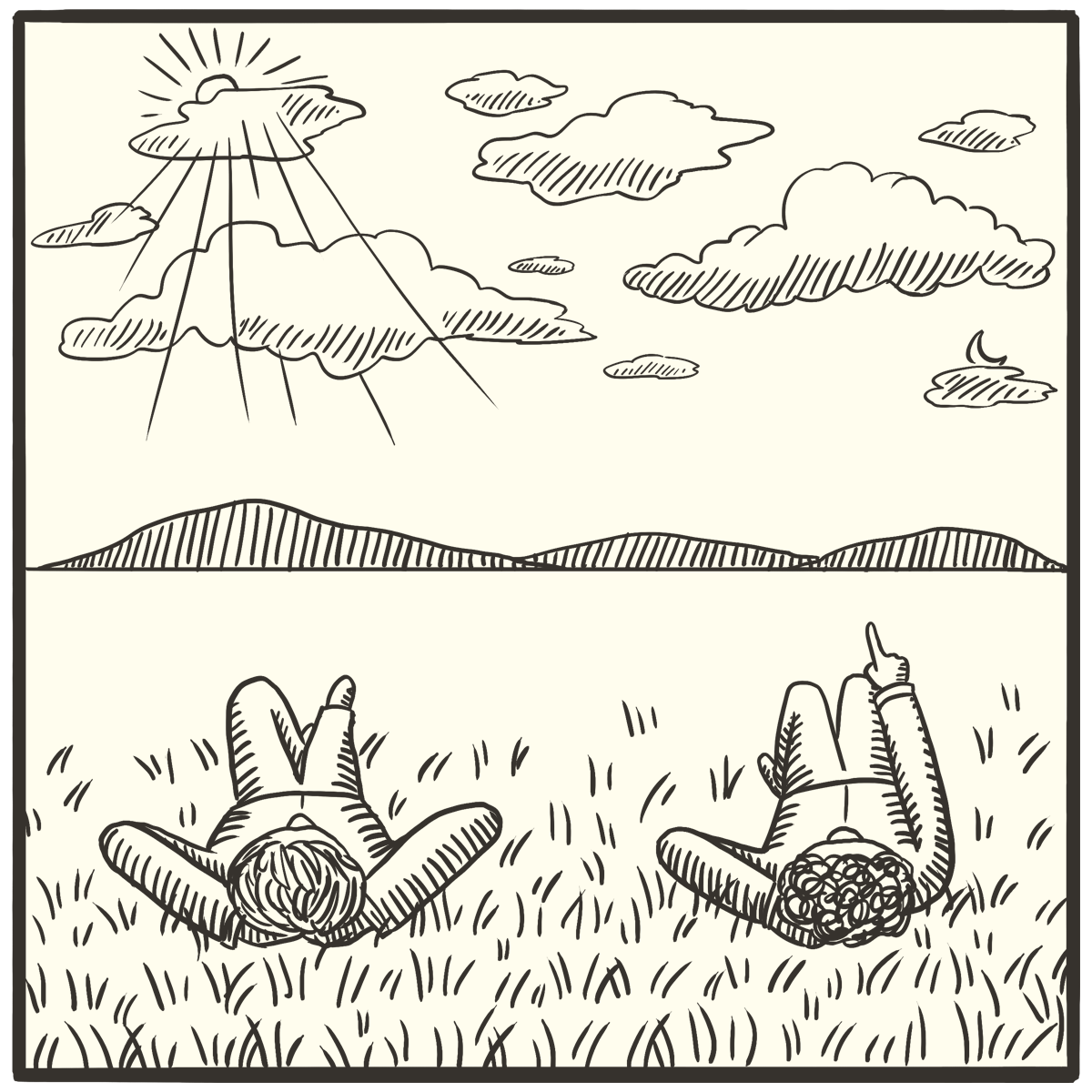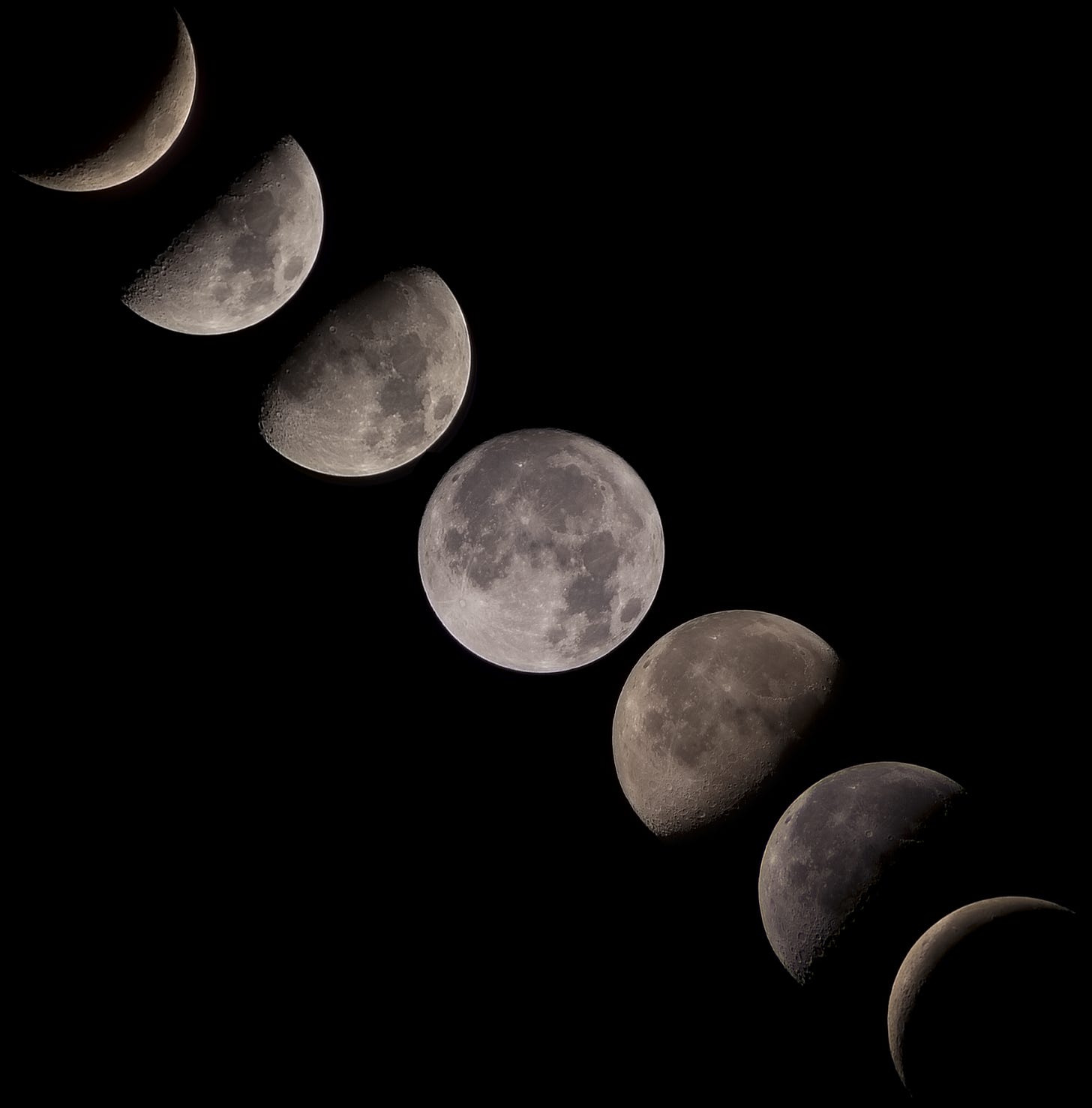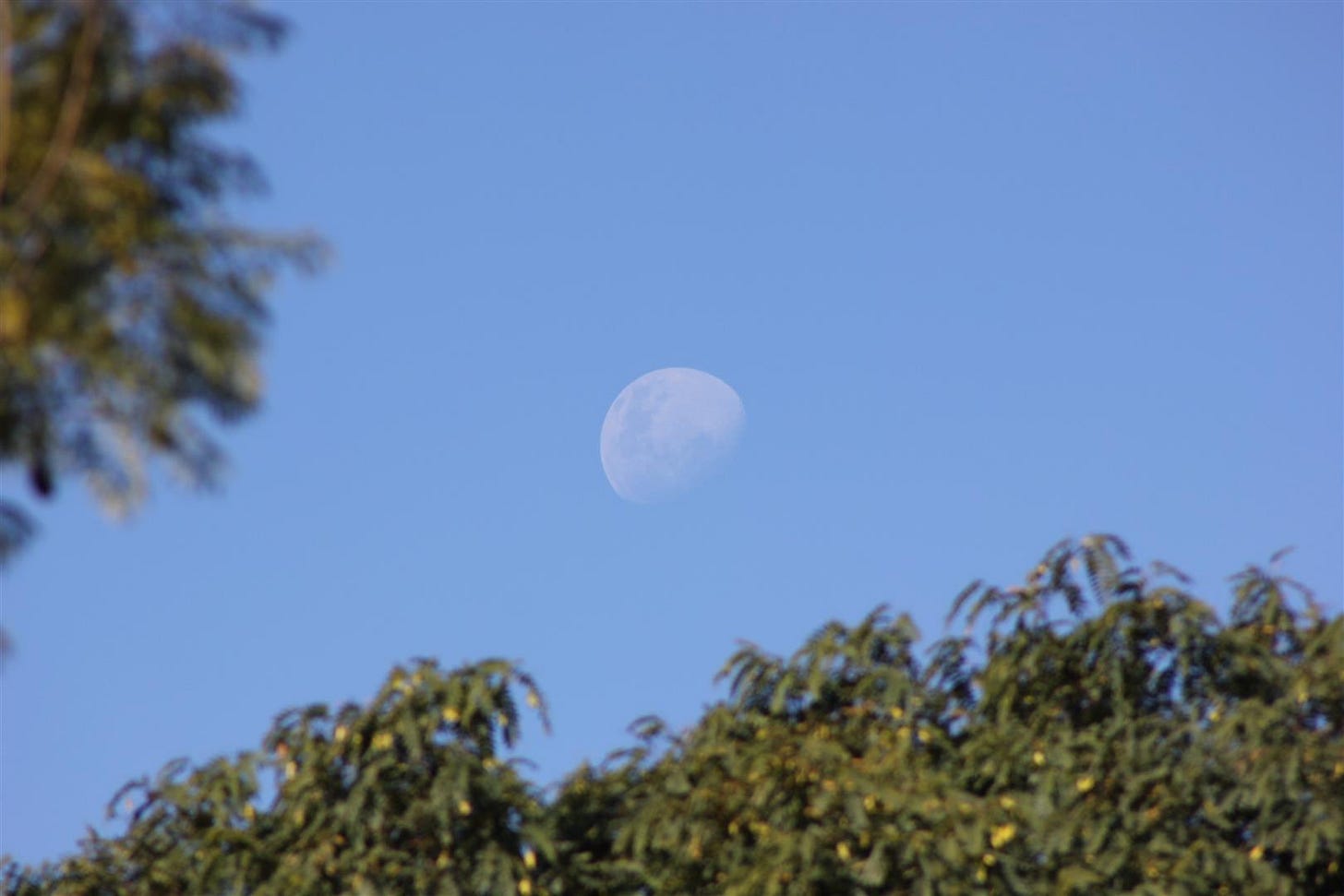Track the Sky
The 46th in the Egan Pattern Language

1. A problem
Everyone (1) learns the basic facts about astronomy — the Earth goes around the Sun, the Moon goes around the Earth, days and nights are caused by our spinning, the seasons are caused by axial tilt, and so on. And everyone (2) looks up and sees the Sun and Moon and stars. But almost no one connects them.
2. Basic plan
Track the “wanderers” — the Sun, the Moon, and eventually other planets. Pick a spot (inside or outside) and trace their paths over time.
Start with the Sun. Where is it right now? Where (and when) will it set? Where will it rise in the morning? Then add on the Moon. Do the same things, but also look at its shape, as it changes from a sickle to a circle and back.
Together, make guesses. What’ll the moon look like next Friday? Where on the horizon will the Sun set in a month, or on your birthday?
Then, when kids are hungry for it, start asking the why’s: why does the Sun move across the sky? Why is the Moon slower than the Sun? Why does it change shape, anyway?
And, the best question of all — how can you look at the Moon and tell what time it is?
3. What you might see
Kids asking why is it cold in winter? and why does the Moon look like a slice? and really chewing over the possible answers.
Rooms turned into planetariums — cutouts of the Sun, Moon, and planets taped to the walls and ceiling, with times written next to them.
Kids getting ridiculously excited when these wanderers come close to each other, and celebrating when they do — feasting on eclipses and alignments, equinoxes and solstices, and annual meteor showers as if they’re holidays.
4. Why?
Here’s a fun experiment: ask someone when the Moon comes out. Do they answer “at night”? If so, hit them on the head with a rolled-up newspaper, because literally half the time the Moon is out in the daytime.
And this is just one fun (and mildly violent) way to show how cut off from the world we all are. We tell kids to go out an “touch grass”, but even then we ignore what’s going on in the sky. And these are the biggest things!
We want kids to connect with the biggest things.
5. Egan’s insight
Where do we see this in the human experience?
It seems telling that every society before ours was positively obsessed with the movements of the Sun and Moon and planets across the sky. Look at the pyramids erected across the world, from Egypt to Belize to St. Louis — you’ll find huge buildings that were designed to track the arcs of the Sun and Moon. In fact, trying to predict just where the various “wanderers” would be is how we first developed a lot of our modern mathematics (like trigonometry).
How might this build different kinds of understanding?
This is grounded in SOMATIC (🤸♀️) understanding with having kids actually go outside and look around. Ultimately, it builds toward PHILOSOPHIC (👩🔬) understanding as kids as “why” — constructing in their minds a 3D model of the solar system.
In the middle, though, it should provoke ROMANTIC (🦹♂️) understanding as kids unlock the mysteries of the cosmos, and provoking awe as they begin to understand the hugeness of the Universe. (What do these weird emoji mean?)
6. This might be especially useful for…
The sorts of kids who are agog for astronomy and the sorts of kids who are agog for astrology.
7. Critical questions
Q: What if we can’t go outside very easily?
Windows can work in a pinch. And planet-finding apps (see below) are a great investment, too.
Q: Ah, this is too advanced for my kids.
Can they find where the Sun is in the sky? Can they guess where it’ll “land”? You can begin this pattern in preschool.
Q: Oh, I see. Then this is too basic for my kids.
Do your kids look forward to the next blood moon? Can they trace the arc of the Sun, and tell you how it’ll vary at the winter solstice? And, just to repeat my favorite question, can they tell what time it is just by looking at the Moon?
If not, then they don’t know what the majority of people throughout history considered basic.
Q: But how can I connect this to more advanced “conceptual” concepts? You know, stuff that might be on an AP or IB test?
I suppose I should say this plainly: this is a gateway drug to modern astronomy. You can use this to discuss the Earth’s rotation, our orbit, our axial tilt, and the orbital mechanics that lead to stuff like lunar phases and solar eclipses.
Can you think of some way this could go terribly, terribly wrong? Frankly, WE WOULD LIKE TO KNOW ABOUT IT. Become a subscriber and join in the comments conversation.
8. Physical space
Spending three bucks on a planet-finding app is a good investment. My favorites are Startracker (iOS, Android) and Star Walk 2 (iOS, Android) and Stellarium (iOS, Android). With these, you can turn a whole room into an astrolabe. (You can also see where the wanderers are even when they’re “under” you.)
9. Who else is doing this?
I believe that the Waldorf people have young kids track the Moon and Sun as part of their nature observations. Readers who are Waldorf-trained: how far does that part of kids’ educations go? And what might we borrow?
(I was actually inspired to do this, though, through an essay in Angela Duckworth’s The Having of Wonderful Ideas, in which she talks about doing a simple version of this with adults as part of their teacher training.)
How might we start small, now?
Just to return one final time to my favorite discovery in tracking the sky: how can you tell the time just from a glimpse at the Moon?
(I figured this out a couple years ago when I woke up at night still exhausted from the day, and happened to look out a south-facing window. I saw the Moon, and realized that I still had hours left to sleep.)
Put your guesses in the comments below! I’ll pick one as a winner, and give them a shout-out in a coming post.
10. Related patterns
This obviously firms up STAR LORE°, which focuses on the stories behind some of the stuff in the night sky. And if you squint just so, it looks a bit like KNOW A PLACE°, in that it uses repeated observations to cultivate a deep knowledge of a thing.
Afterword:
I’m happy to announce that I’ve now shared the crappy, garbage-like bucket of notes with folk who’ve signed up for the Skeleton Army. From such stinky begins will come a real book! We’ve got a lot of people in it (more than I anticipated), but there’s still time to join before we formally start.
Our first official Egan and ChatGPT event went well! Video’s up at the bottom of the post; the next one will be Saturday, October 5 at 3pm Eastern / 12pm Pacific. Subject: science. (I’m swapping out the planned book club for it.)
Our year-long Learning in Depth cohort begins in a week! Still some room. If you want to change you and/or a kid’s life (and for the better!), and think (as I do) that Egan’s approach to learning holds water, you’ll want to be considering this.




Out with a friend at night recently, I realized that there's one utterly basic aspect to viewing the sky that's not known by a lot of modern-age folk: EVERYTHING seems to move east to west across the sky. The Sun, the Moon, the planets, the stars... And that's because that motion is just apparent motion: it's US who are spinning eastward.
And when I pause and think about it, this neatly explains something that I've struggled to remember: the Moon appears SLOWER than the Sun because it's actually falling around the Earth in the other direction. (And that just-so-happens to be the direction that the Earth is rotating: a small evidence that the Moon came from Earth in the first place.)
One thing to try to note: when does the Moon reach it's own "noon"? When is it as high in the sky as it's gonna go?
I've actually started a simple part of this recently with our older son, who's almost three.
We mark off the days on his calendar as part of his bedtime routine. Mainly I started doing it to practice counting, as well as learning the days of the week.
But like most calendars, it also shows the phases of the moon. So when we see the moon out, I try to point out what phase it's in and connect it to the calendar.
Both he and his younger brother get pretty excited about locating the moon in the sky, so I think we're on the right track. In another year or two, we'll start teaching them about how days and seasons and years work. And yes, I'm hoping he'll learn to tell time by the moon. ;-)
But unfortunately, the rest of the sky in my neighborhood is pretty underwhelming. Even on a clear night, I can see only about a dozen stars, and I can't make out a single constellation.